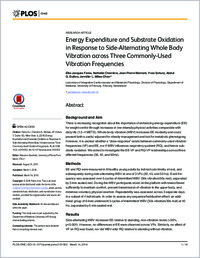Energy expenditure and substrate oxidation in response to side-alternating whole body vibration across three commonly-used vibration frequencies
- Fares, Elie-Jacques Laboratory of Integrative Cardiovascular and Metabolic Physiology, Department of Medicine, University of Fribourg, Switzerland
- Charrière, Nathalie Laboratory of Integrative Cardiovascular and Metabolic Physiology, Department of Medicine, University of Fribourg, Switzerland
- Montani, Jean-Pierre Laboratory of Integrative Cardiovascular and Metabolic Physiology, Department of Medicine, University of Fribourg, Switzerland
- Schutz, Yves Laboratory of Integrative Cardiovascular and Metabolic Physiology, Department of Medicine, University of Fribourg, Switzerland
- Dulloo, Abdul G. Laboratory of Integrative Cardiovascular and Metabolic Physiology, Department of Medicine, University of Fribourg, Switzerland
- Miles-Chan, Jennifer L. Laboratory of Integrative Cardiovascular and Metabolic Physiology, Department of Medicine, University of Fribourg, Switzerland
-
14.03.2016
Published in:
- PLOS ONE. - 2016, vol. 11, no. 3, p. e0151552
English
There is increasing recognition about the importance of enhancing energy expenditure (EE) for weight control through increases in low-intensity physical activities comparable with daily life (1.5–4 METS). Whole-body vibration (WBV) increases EE modestly and could present both a useful adjuvant for obesity management and tool for metabolic phenotyping. However, it is unclear whether a “dose-response” exists between commonly-used vibration frequencies (VF) and EE, nor if WBV influences respiratory quotient (RQ), and hence substrate oxidation. We aimed to investigate the EE-VF and RQ-VF relationships across three different frequencies (30, 40, and 50Hz).Methods: EE and RQ were measured in 8 healthy young adults by indirect calorimetry at rest, and subsequently during side-alternating WBV at one of 3 VFs (30, 40, and 50 Hz). Each frequency was assessed over 5 cycles of intermittent WBV (30s vibration/30s rest), separated by 5 min seated rest. During the WBV participants stood on the platform with knees flexed sufficiently to maintain comfort, prevent transmission of vibration to the upper body, and minimise voluntary physical exertion. Repeatability was assessed across 3 separate days in a subset of 4 individuals. In order to assess any sequence/habituation effect, an additional group of 6 men underwent 5 cycles of intermittent WBV (30s vibration/30s rest) at 40 Hz, separated by 5 min seated rest.Results: Side-alternating WBV increased EE relative to standing, non-vibration levels (+36%, p<0.001). However, no differences in EE were observed across VFs. Similarly, no effect of VF on RQ was found, nor did WBV alter RQ relative to standing without vibration.Conclusion: No relationship could be demonstrated between EE and VF in the range of 30-50Hz, and substrate oxidation did not change in response to WBV. Furthermore, the thermogenic effect of intermittent WBV, whilst robust, was quantitatively small (<2 METS)
- Faculty
- Faculté des sciences et de médecine
- Department
- Département de Médecine
- Language
-
- English
- Classification
- Biological sciences
- License
- License undefined
- Identifiers
-
- RERO DOC 259490
- DOI 10.1371/journal.pone.0151552
- Persistent URL
- https://folia.unifr.ch/unifr/documents/305001
Statistics
Document views: 58
File downloads:
- far_ees.PDF: 72
